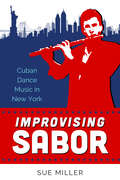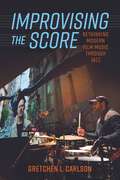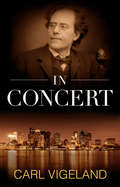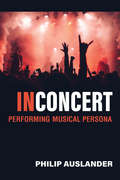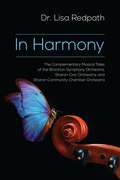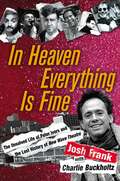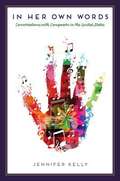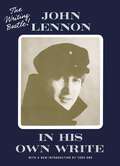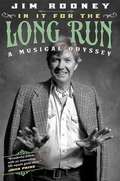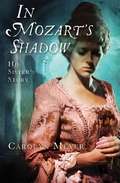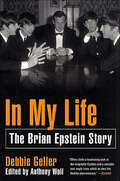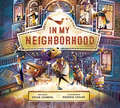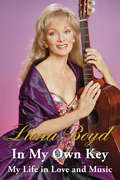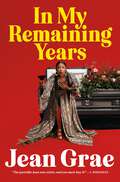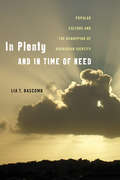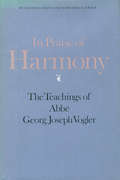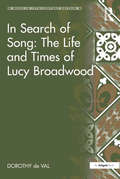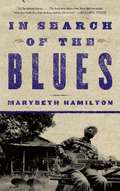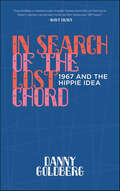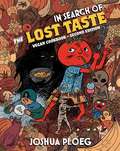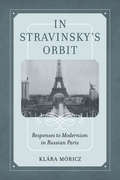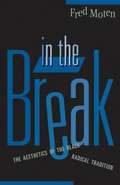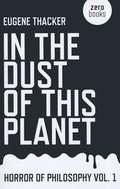- Table View
- List View
Improvising Sabor: Cuban Dance Music in New York
by Sue MillerImprovising Sabor: Cuban Dance Music in New York begins in 1960s New York and examines in rich detail the playing styles and international influence of important figures in US Latin music. Such innovators as José Fajardo, Johnny Pacheco, George Castro, and Eddy Zervigón dazzled the Palladium ballroom and other Latin music venues in those crucible years. Author Sue Miller focuses on the Cuban flute style in light of its transformations in the US after the 1959 revolution and within the vibrant context of 1960s New York. While much about Latin jazz and salsa has been written, this book focuses on the relatively unexplored New York charangas that were performing during the chachachá and pachanga craze of the early sixties. Indeed, many accounts cut straight from the 1950s and the mambo to the bugalú’s development in the late 1960s with little mention of the chachachá and pachanga’s popularity in the mid-twentieth century. Improvising Sabor addresses not only this lost and ignored history, but contends with issues of race, class, and identity while evaluating differences in style between players from prerevolution Cuban charangas and those of 1960s New York. Through comprehensive explorations and transcriptions of numerous musical examples as well as interviews with and commentary from Latin musicians, Improvising Sabor highlights a specific sabor that is rooted in both Cuban dance music forms and the rich performance culture of Latin New York. The distinctive styles generated by these musicians sparked compelling points of departure and influence.
Improvising the Score: Rethinking Modern Film Music through Jazz
by Gretchen L. Carlson2023 Jazz Journalists Association (JJA) Jazz Awards for Books of the Year—Honorable Mention RecipientOn December 4, 1957, Miles Davis revolutionized film soundtrack production, improvising the score for Louis Malle’s Ascenseur pour l’échafaud. A cinematic harbinger of the French New Wave, Ascenseur challenged mainstream filmmaking conventions, emphasizing experimentation and creative collaboration. It was in this environment during the late 1950s to 1960s, a brief “golden age” for jazz in film, that many independent filmmakers valued improvisational techniques, featuring soundtracks from such seminal figures as John Lewis, Thelonious Monk, and Duke Ellington. But what of jazz in film today? Improvising the Score: Rethinking Modern Film Music through Jazz provides an original, vivid investigation of innovative collaborations between renowned contemporary jazz artists and prominent independent filmmakers. The book explores how these integrative jazz-film productions challenge us to rethink the possibilities of cinematic music production. In-depth case studies include collaborations between Terence Blanchard and Spike Lee (Malcolm X, When the Levees Broke), Dick Hyman and Woody Allen (Hannah and Her Sisters), Antonio Sánchez and Alejandro González Iñárritu (Birdman), and Mark Isham and Alan Rudolph (Afterglow). The first book of its kind, this study examines jazz artists’ work in film from a sociological perspective, offering rich, behind-the-scenes analyses of their unique collaborative relationships with filmmakers. It investigates how jazz artists negotiate their own “creative labor,” examining the tensions between improvisation and the conventionally highly regulated structures, hierarchies, and expectations of filmmaking. Grounded in personal interviews and detailed film production analysis, Improvising the Score illustrates the dynamic possibilities of integrative artistic collaborations between jazz, film, and other contemporary media, exemplifying its ripeness for shaping and invigorating twenty-first-century arts, media, and culture.
In Concert
by Carl A. VigelandAn intimate, moving, dramatic story about the musicians in a great orchestra who make music come alive in performance and recording. The musicians here are members of the fabled Boston Symphony Orchestra, led by conductor Seiji Ozawa, during a season highlighted by Mahler's Second Symphony, The Resurrection.
In Concert: Performing Musical Persona
by Philip AuslanderThe conventional way of understanding what musicians do as performers is to treat them as producers of sound; some even argue that it is unnecessary to see musicians in performance as long as one can hear them. But musical performance, counters Philip Auslander, is also a social interaction between musicians and their audiences, appealing as much to the eye as to the ear. In Concert: Performing Musical Persona he addresses not only the visual means by which musicians engage their audiences through costume and physical gesture, but also spectacular aspects of performance such as light shows. Although musicians do not usually enact fictional characters on stage, they nevertheless present themselves to audiences in ways specific to the performance situation. Auslander’s term to denote the musician’s presence before the audience is musical persona. While presence of a musical persona may be most obvious within rock and pop music, the book’s analysis extends to classical music, jazz, blues, country, electronic music, laptop performance, and music made with experimental digital interfaces. The eclectic group of performers discussed include the Beatles, Miles Davis, Keith Urban, Lady Gaga, Nicki Minaj, Frank Zappa, B. B. King, Jefferson Airplane, Virgil Fox, Keith Jarrett, Glenn Gould, and Laurie Anderson.
In Harmony: The Complementary Musical Tales of the Brockton Symphony Orchestra, Sharon Civic Orchestra, and Sharon Community Chamber Orchestra
by Dr. Lisa M. RedpathIn Harmony: The Complementary Musical Tales of the Brockton Symphony Orchestra, Sharon Civic Orchestra, and Sharon Community Chamber Orchestra is a stirring, historical account of these three Massachusetts ensembles. Each chapter documents the orch
In Heaven Everything Is Fine: The Unsolved Life of Peter Ivers and the Lost History of New Wave Theatre
by Josh Frank Charlie BuckholtzOn March 3, 1983, Peter Ivers was found bludgeoned to death in his loft in downtown Los Angeles, ending a short-lived but essential pop cultural moment that has been all but lost to history. For the two years leading up to his murder, Ivers had hosted the underground but increasingly popular LA-based music and sketch-comedy cable show New Wave Theatre. The late '70s through early '80s was an explosive time for pop culture:Saturday Night Live and National Lampoon were leading a comedy renaissance, while punk rock and new wave were turning the music world on its head. New Wave Theatre brought together for the first time comedians-turned-Hollywood players like John Belushi, Chevy Chase, and Harold Ramis with West Coast punk rockers Black Flag, the Dead Kennedys, Fear, and others, thus transforming music and comedy forever. The show was a jubilant, chaotic punk-experimental-comedy cabaret, and Ivers was its charismatic leader and muse. He was, in fact, the only person with the vision, the generosity of spirit, and the myriad of talented friends to bring together these two very different but equally influential worlds, and with his death the improbable and electric union of punk and comedy came to an end. The magnetic, impishly brilliant Ivers was a respected musician and composer (in addition to several albums, he wrote the music for the centerpiece song of David Lynch's cult classic Eraserhead) whose sublime and bizarre creativity was evident in everything he did. He was surrounded by people who loved him, many of them luminaries: his best friend from his Harvard days was Doug Kenney, founder ofNational Lampoon; he was also close to Harold Ramis and John Belushi. Upon his death, Ivers was just beginning to get mainstream recognition. In Heaven Everything Is Fine is the first book to explore both the fertile, gritty scene that began and ended with New Wave Theatre and the life and death of its guiding spirit. Josh Frank, author of Fool the World: The Oral History of a Band Called Pixies, interviewed hundreds of people from Ivers's circle, including Jello Biafra, Stockard Channing, and David Lynch, and we hear in their own words about Ivers and the marvelous world he inhabited. He also spoke with the Los Angeles Police Department about Ivers's still-unsolved murder, and, as a result of his research, the Cold Case Unit has reopened the investigation. In Heaven Everything Is Fine is a riveting account of a gifted artist, his tragic death, and a little-known yet crucial chapter in American pop history.
In Her Own Words: Conversations with Composers in the United States
by Jennifer KellyThis collection of new interviews with twenty-five accomplished female composers substantially advances our knowledge of the work, experiences, compositional approaches, and musical intentions of a diverse group of creative individuals. With personal anecdotes and sometimes surprising intimacy and humor, these wide-ranging conversations represent the diversity of women composing music in the United States from the mid-twentieth century into the twenty-first. The composers work in a variety of genres including classical, jazz, multimedia, or collaborative forms for the stage, film, and video games. Their interviews illuminate questions about the status of women composers in America, the role of women in musical performance and education, the creative process and inspiration, the experiences and qualities that contemporary composers bring to their craft, and balancing creative and personal lives. Candidly sharing their experiences, advice, and views, these vibrant, thoughtful, and creative women open new perspectives on the prospects and possibilities of making music in a changing world.
In His Own Write
by John LennonAN OMNIBUS EDITION OF JOHN LENNON’ S WHIMSICAL POETRY, PROSE, AND DRAWINGS, REISSUED IN CELEBRATION OF THE 70TH ANNIVERSARY OF HIS BIRTH.
In It for the Long Run: A Musical Odyssey (Music in American Life)
by Jim RooneyInspired by the Hank Williams and Leadbelly recordings he heard as a teenager growing up outside of Boston, Jim Rooney began a musical journey that intersected with some of the biggest names in American music including Bob Dylan, James Taylor, Bill Monroe, Muddy Waters, and Alison Krauss. In It for the Long Run: A Musical Odyssey is Rooney's kaleidoscopic first-hand account of more than five decades of success as a performer, concert promoter, songwriter, music publisher, engineer, and record producer. As witness to and participant in over a half century of music history, Rooney provides a sophisticated window into American vernacular music. Following his stint as a "Hayloft Jamboree" hillbilly singer in the mid-1950s, Rooney managed Cambridge's Club 47, a catalyst of the '60's folk music boom. He soon moved to the Newport Folk Festival as talent coordinator and director where he had a front row seat to Dylan "going electric." In the 1970s Rooney's odyssey continued in Nashville where he began engineering and producing records. His work helped alternative country music gain a foothold in Music City and culminated in Grammy nominations for singer-songwriters John Prine, Iris Dement, and Nanci Griffith. Later in his career he was a key link connecting Nashville to Ireland's folk music scene. Writing songs or writing his memoir, Jim Rooney is the consummate storyteller. In It for the Long Run: A Musical Odyssey is his singular chronicle from the heart of Americana.
In Love With Voices: A Jazz Memoir
by Brian Q. TorffIn his memoir, Torff takes us beyond the music by adding depth with his vision of American music, and paints vivid portraits of the musicians with whom he played.
In Mozart's Shadow: His Sister's Story
by Carolyn MeyerNannerl Mozart was a musical prodigy who seemed to have a brilliant future. But once her younger brother, Wolfgang, began composing symphonies at the age of five, her career and talents were utterly eclipsed. Here, at last, is Nannerl's heart-wrenching tale. It's the story of her undying passion for music; her relationship with her "miracle boy" brother; and her life as the "other Mozart," the one forgotten by history. The acclaimed Carolyn Meyer has written a powerful historical novel about a little-known but gifted musician who never stopped dreaming. Includes an author's note.
In My Life: The Brian Epstein Story
by Debbie GellerWithout the determination, magnetism, vision, good manners, respectable clothes and financial security of Brian Epstein, no one would ever have heard of John, Paul, George, and Ringo. In Liverpool, in December 1961, Brian Epstein met the Beatles in his small office and signed a management deal. The rest may be history, but it's a history that Epstein created, along with a blueprint for all pop groups since.Out of the public eye, Epstein was flamboyant and charismatic. He drank, gambled compulsively and took drugs to excess. But people remember his wit, charm and capacity to inspire affection and loyalty. That's when he wasn't depressed, even suicidal. Epstein was Jewish in a society filled with anti-Semitism. He was homosexual at a time when it was a crime to be gay, and from his teenage days to the end of his life he suffered arrests, beatings and blackmail--all of which had to be kept secret.In In My Life: The Brian Epstein Story, Debbie Geller tells the story of Epstein's complicated life through the reminiscences of his friends and family. Based on dozens of interviews--with Paul McCartney, George Martin and Marianne Faithfull, among others--plus many of Epstein's personal diaries, this book uncovers the truth behind the enigmatic young man who unintentionally caused a cultural revolution--and in the process destroyed himself.
In My Neighborhood
by Oscar LoubrielSLJ Star! A beautifully realized city inhabited by musical instruments A search for one’s place in the world provides the storyline: The narrator, a drum, feels like an outcast because he alone—unlike his family and friends—cannot play a melody. Like all kids growing up, he must find out where he fits. The narrator, a drum, wanders the streets of Coelho’s vividly realized city of musical instruments—where even the birds sprout miniature trumpets from their mouths—feeling like an outcast because he alone, among all his family and neighbors, can’t play a melody. He adores his violin brother, cello father, and piano mother but feels he has nothing to offer to their music. search for identity in a city of musical instruments. "My father is Cello, and oh, what a fellow.The tone of his laugh is low, smooth, and mellow.But me? My name’s Drum. BOOM-CLACK, RAT-A-TAT.My head is a snare and I wear a hi-hat.My stomach’s a bass drum, my arms are drumsticks,and my only song is CLICK-CLACK, CLACK-CLICK." But one day a trio of saxophones ask him to join their band, and what they tell him gives him an epiphany "So that’s what a drum does! I now understand.I don’t carry a tune; I carry a band." But he must still prove it to himself, and that takes all his courage. Loubriel’s story of bravery and identity, infused with Latin rhythms and joy, provides a fine vehicle for Coelho’s vibrant technique and palette. Coelho’s city of music bursts with exuberance. In backmatter,Loubriel, a lifelong drummer, explains how the drum kit lays a song’s foundation. The bass drum is the heartbeat; the hi hat is the dynamic metronome; the snare drum is the drum kit’s singer.
In My Own Key: My Life in Love and Music
by Liona BoydExotic venues, sold-out concerts, and the companionship of the world’s most powerful people have given Liona Boyd a lifestyle that, like her music, is one in a million. Exotic venues, sold-out concerts, and the companionship of the world’s most powerful people have given Liona Boyd a lifestyle that, like her music, is one in a million. The internationally acclaimed classical guitarist has crossed numerous boundaries, both musically and romantically. In this colourful memoir covering her life up to 1998, she serves up a rich and fascinating mix: childhood with her progressive parents in England, Canada, and Mexico, exacting music studies in Toronto, down-and-out years in London and Paris, her eight-year romance with Canadian prime minister Pierre Elliott Trudeau, drug experimentation in a Mexican artists’ colony, and whirlwind trips around the globe to eminent concert stages. It all makes for a rousing, feisty, passionate tale, as compelling and entrancing as the music of her Ramírez guitar.
In My Remaining Years
by Jean GraeA collection of darkly humorous, intensely personal essays by cult fave and multi-hyphenate artist Jean GraeIn My Remaining Years, by creative juggernaut Jean Grae, debunks the myth that coming-of-age narratives should be reserved for the kids, providing a much-needed rallying cry for those of us still trying to figure it out in our forties. These laugh-out-loud essays cover everything from aging gracefully (with and without botox), what happens when you look for community and almost start a cult, befriending childhood demons (Hi Mumm-ra!), gender fluidity in middle age, the cost of being too fabulous, and the various gymnastics we do to avoid becoming our parents, taking us from her childhood in 1980s New York City to present-day Baltimore. In these pages, Jean captures magic in a bottle, distilling the feeling of hanging out with your smartest, funniest, and most brutally honest best friend.
In Plenty and in Time of Need: Popular Culture and the Remapping of Barbadian Identity (Critical Caribbean Studies)
by Lia T. BascombIn Plenty and in Time of Need demonstrates how the unique history of Barbados has contributed to complex relations of national, gendered, and sexual identities, and how these identities are represented and interpreted on a global stage. As the most widespread manifestation of social commentary, the book uses music and performance to analyze the competing ideals and realities of the national culture. It details the histories of prominent musical artists, including the prolific Pan-Africanist calypsonian the Mighty Gabby, the world-renowned Merrymen, Soca Queen Alison Hinds, artist/activist Rupee, and international superstar Rihanna. Using these artists, the project analyzes how femininity, masculinity, and sexuality are put in service of Barbadian nationalism. By examining websites, blogs, and digital products of these artists in conversation with Barbadian tourism, the book re-examines the ways in which commodity, sexuality, gender performance, and diasporic consciousness undergird individual careers and national representations.
In Praise of Harmony: The Teachings of Abbé Georg Joseph Vogler
by Floyd K. Grave Margaret G. GraveIn Praise of Harmony is the first critical and biographical study of Vogler to appear in English.
In Quest of Music
by Irving KolodinThe music critic and writer maps out the road that music and musicians have traveled, particularly in the US, since 1900, both in classical music and jazz.
In Search of Song: The Life And Times Of Lucy Broadwood (Music in Nineteenth-Century Britain)
by Dorothy de ValBorn into the famous family of piano makers, Lucy Broadwood (1858-1929) became one of the chief collectors and scholars of the first English folk music revival in the late nineteenth and early twentieth centuries. Privately educated and trained as a classical musician and singer, she was inspired by her uncle to collect local song from her native Sussex. The desire to rescue folk song from an aging population led to the foundation of the Folk Song Society, of which she was a founder member. Mentor to younger collectors such as Percy Grainger but often at loggerheads with fellow collector Cecil Sharp and the young Ralph Vaughan Williams, she eventually ventured into Ireland and Scotland, while remaining an eclectic contributor and editor of the Society’s Journal, which became a flagship for scholarly publication of folksong. She also published arrangements of folk songs and her own compositions which attracted the attention of singers such as Harry Plunket Greene. Using an array of primary sources including the diaries Broadwood kept throughout her adult life, Dorothy de Val provides a lively biography which sheds new light on her early years and chronicles her later busy social, artistic and musical life while acknowledging the underlying vulnerability of single women at this time. Her account reveals an intelligent, generous though reserved woman who, with the help of her friends, emerged from the constraints of a Victorian upbringing to meet the challenges of the modern world.
In Search of the Blues
by Marybeth HamiltonIn this extraordinary reconstruction of the origins of the blues, historian Marybeth Hamilton demonstrates that the story as we know it is largely a myth. Following the trail of characters like Howard Odum, who combed Mississippi's back roads with a cylinder phonograph to record vagrants, John and Alan Lomax, who prowled Southern penitentiaries and unearthed the rough, melancholy vocals of Leadbelly, and James McKune, a recluse whose record collection came to define the primal sounds of the Delta blues, Hamilton reveals this musical form to be the culmination of a longstanding white fascination with the exotic mysteries of black music.By excavating the history of the Delta blues, Hamilton reveals the extent to which American culture has been shaped by white fantasies of racial difference.
In Search of the Lost Chord: 1967 and the Hippie Idea
by Danny GoldbergThis paperback edition of Goldberg’s highly acclaimed homage to 1967 includes a new afterword and twenty beautiful and evocative photographs.“Antiwar radicals, recoiling from soullessness, challenged the church of technocratic rationality. Taking this challenge seriously, recovering the mood of an extended moment, requires beginning earlier and ending later than 1968. Cultural upheaval cannot be confined by the calendar. At least one contribution to the literature, the music industry executive Danny Goldberg’s In Search of the Lost Chord, treats 1967 as the defining moment when ‘the hippie idea’ still held transformational promise, and countercultural protest had not yet succumbed to police violence, undercover provocateurs, or media caricature—while 1968, in contrast, was a dark time of assassinations, riots, and the resurgence of the right.” —New York Review of Books“[Goldberg’s] newest book, In Search of the Lost Chord: 1967 and the Hippie Idea, explores and fuses together the musical, political, and spiritual revolutions of the time into a narrative about a moment when ‘there was an instant sense of tribal intimacy one could have even with a stranger.'” —Rolling StoneIn Search of the Lost Chord is a subjective history of 1967, the year Danny Goldberg graduated from high school. It is also a refreshing and new analysis of the era; by looking at not only the political causes, but also the spiritual, musical, and psychedelic movements, Goldberg provides a unique perspective on how and why the legacy of 1967 lives on today. 1967 was the year of the release of the Beatles’ Sgt. Pepper’s Lonely Hearts Club Band, and of debut albums from the Doors, the Grateful Dead, Jimi Hendrix, and Janis Joplin, among many others. 1967 was also the year of the Summer of Love; the year that millions of now-illegal LSD tabs flooded America; Muhammad Ali was convicted of avoiding the draft; Martin Luther King Jr. publicly opposed the war in Vietnam; Stokely Carmichael championed Black Power; Israel won the Six-Day War; and Che Guevara was murdered. It was the year that hundreds of thousands of protesters vainly attempted to levitate the Pentagon. It was the year the word “hippie” peaked and died, and the Yippies were born. Exhaustively researched and informed by interviews and conversations with Allen Ginsberg, Timothy Leary, Ram Dass, Tom Hayden, Cora Weiss, Grace Slick, and others, In Search of the Lost Chord is a mosaic of seminal moments in the psychedelic, spiritual, rock-and-roll, and political protest cultures of 1967. This paperback edition includes a brand-new afterword by the author, along with twenty photographs by Peter Simon.
In Search of the Lost Taste: The Adventure Vegan Cookbook
by Joshua PloegJoshua Ploeg's cooking blows my mind so much that a secret door opens in the back of my head and white doves, musical notes, and winged horses fly out. His cooking is transcendent: Dangerous, strange and perfect. It¹s full of colorful tastes that explode in your mouth like Pop Rocks flavor combinations you never thought possible. Crazy alchemy. Freaky magic. Joshua's the Traveling Chef; you make an appointment, he shows up at your house with a load of groceries, makes an incredible multi-course vegan meal using your pots and pans, and then he's gone like the Lone Ranger riding into a big Texas sunset. Joshua's been in a bunch of hardcore bands and he brings all the good things punk rock gave us: risk, passion, creativity, and weirdness; then he applies them to his meals. I randomly lucked into one of his dinners last year. I usually eat really fast and mindlessly, but I had to take this one slow and let all the flavors develop and do their respective stuff. Each had its own distinctive note its own voice that rang out to let it be known that it was something special and unique. It was an experience in the finest sense of the word.
In Stravinsky's Orbit: Responses to Modernism in Russian Paris (California Studies in 20th-Century Music #26)
by Klara MoriczThe Bolsheviks’ 1917 political coup caused a seismic disruption in Russian culture. Carried by the first wave of emigrants, Russian culture migrated West, transforming itself as it interacted with the new cultural environment and clashed with exported Soviet trends. In this book, Klára Móricz explores the transnational emigrant space of Russian composers Igor Stravinsky, Vladimir Dukelsky, Sergey Prokofiev, Nicolas Nabokov, and Arthur Lourié in interwar Paris. Their music reflected the conflict between a modernist narrative demanding innovation and a narrative of exile wedded to the preservation of prerevolutionary Russian culture. The emigrants’ and the Bolsheviks’ contrasting visions of Russia and its past collided frequently in the French capital, where the Soviets displayed their political and artistic products. Russian composers in Paris also had to reckon with Stravinsky’s disproportionate influence: if they succumbed to fashions dictated by their famous compatriot, they risked becoming epigones; if they kept to their old ways, they quickly became irrelevant. Although Stravinsky’s neoclassicism provided a seemingly neutral middle ground between innovation and nostalgia, it was also marked by the exilic experience. Móricz offers this unexplored context for Stravinsky’s neoclassicism, shedding new light on this infinitely elusive term.
In The Break: The Aesthetics Of The Black Radical Tradition
by Fred MotenInvestigates the connections between jazz, sexual identity, and radical black politics In his controversial essay on white jazz musician Burton Greene, Amiri Baraka asserted that jazz was exclusively an African American art form and explicitly fused the idea of a black aesthetic with radical political traditions of the African diaspora. In the Break is an extended riff on &“The Burton Greene Affair,&” exploring the tangled relationship between black avant-garde in music and literature in the 1950s and 1960s, the emergence of a distinct form of black cultural nationalism, and the complex engagement with and disavowal of homoeroticism that bridges the two. Fred Moten focuses in particular on the brilliant improvisatory jazz of John Coltrane, Ornette Coleman, Albert Ayler, Eric Dolphy, Charles Mingus, and others, arguing that all black performance—culture, politics, sexuality, identity, and blackness itself—is improvisation. For Moten, improvisation provides a unique epistemological standpoint from which to investigate the provocative connections between black aesthetics and Western philosophy. He engages in a strenuous critical analysis of Western philosophy (Heidegger, Kant, Husserl, Wittgenstein, and Derrida) through the prism of radical black thought and culture. As the critical, lyrical, and disruptive performance of the human, Moten&’s concept of blackness also brings such figures as Frederick Douglass and Karl Marx, Cecil Taylor and Samuel R. Delany, Billie Holiday and William Shakespeare into conversation with each other. Stylistically brilliant and challenging, much like the music he writes about, Moten&’s wide-ranging discussion embraces a variety of disciplines—semiotics, deconstruction, genre theory, social history, and psychoanalysis—to understand the politicized sexuality, particularly homoeroticism, underpinning black radicalism. In the Break is the inaugural volume in Moten&’s ambitious intellectual project-to establish an aesthetic genealogy of the black radical tradition
In The Dust of This Planet (Horror of Philosophy, volume #1)
by Eugene ThackerThe world is increasingly unthinkable, a world of planetary disasters, emerging pandemics, and the looming threat of extinction. In this book Eugene Thacker suggests that we look to the genre of horror as offering a way of thinking about the unthinkable world. To confront this idea is to confront the limit of our ability to understand the world in which we live - a central motif of the horror genre. In the Dust of This Planet explores these relationships between philosophy and horror. In Thacker's hands, philosophy is not academic logic-chopping; instead, it is the thought of the limit of all thought, especially as it dovetails into occultism, demonology, and mysticism. Likewise, Thacker takes horror to mean something beyond the focus on gore and scare tactics, but as the under-appreciated genre of supernatural horror in fiction, film, comics, and music.
